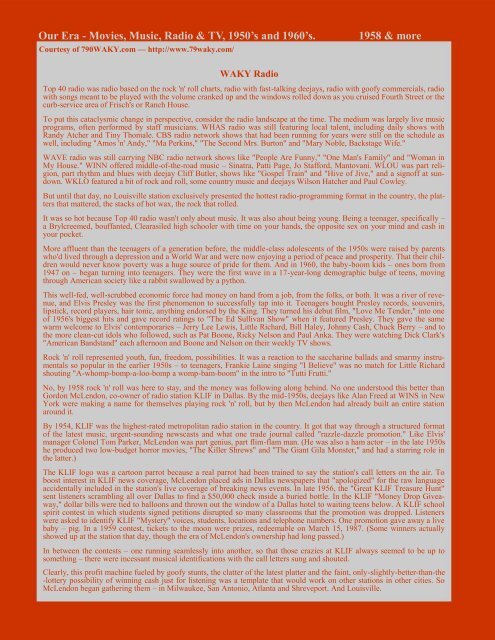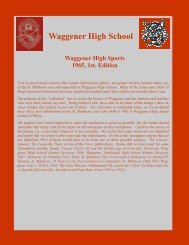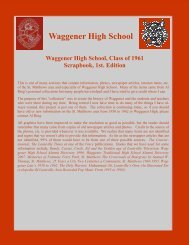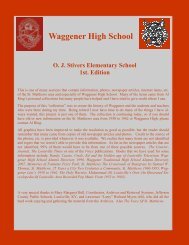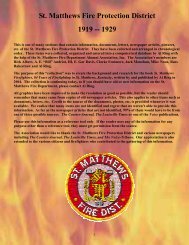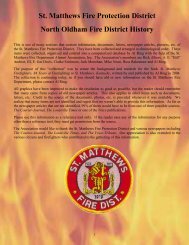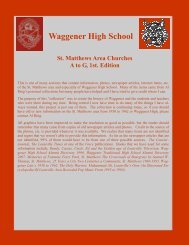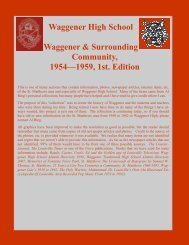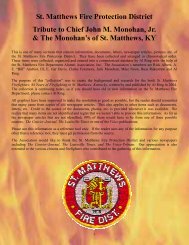<strong>Our</strong> <strong>Era</strong> - <strong>Movies</strong>, <strong>Music</strong>, <strong>Radio</strong> & <strong>TV</strong>, 1950‟s <strong>and</strong> 1960‟s.Courtesy of 790WAKY.com — http://www.79waky.com/1958 & moreWAKY <strong>Radio</strong>Top 40 radio was radio based on the rock 'n' roll charts, radio with fast-talking deejays, radio with goofy commercials, radiowith songs meant to be played with the volume cranked up <strong>and</strong> the windows rolled down as you cruised Fourth Street or thecurb-service area of Frisch's or Ranch House.To put this cataclysmic change in perspective, consider the radio l<strong>and</strong>scape at the time. The medium was largely live musicprograms, often performed by staff musicians. WHAS radio was still featuring local talent, including daily shows withR<strong>and</strong>y Atcher <strong>and</strong> Tiny Thomale. CBS radio network shows that had been running for years were still on the schedule aswell, including "Amos 'n' Andy," "Ma Perkins," "The Second Mrs. Burton" <strong>and</strong> "Mary Noble, Backstage Wife."WAVE radio was still carrying NBC radio network shows like "People Are Funny," "One Man's Family" <strong>and</strong> "Woman inMy House." WINN offered middle-of-the-road music – Sinatra, Patti Page, Jo Stafford, Mantovani. WLOU was part religion,part rhythm <strong>and</strong> blues with deejay Cliff Butler, shows like "Gospel Train" <strong>and</strong> "Hive of Jive," <strong>and</strong> a signoff at sundown.WKLO featured a bit of rock <strong>and</strong> roll, some country music <strong>and</strong> deejays Wilson Hatcher <strong>and</strong> Paul Cowley.But until that day, no Louisville station exclusively presented the hottest radio-programming format in the country, the plattersthat mattered, the stacks of hot wax, the rock that rolled.It was so hot because Top 40 radio wasn't only about music. It was also about being young. Being a teenager, specifically –a Brylcreemed, bouffanted, Clearasiled high schooler with time on your h<strong>and</strong>s, the opposite sex on your mind <strong>and</strong> cash inyour pocket.More affluent than the teenagers of a generation before, the middle-class adolescents of the 1950s were raised by parentswho'd lived through a depression <strong>and</strong> a World War <strong>and</strong> were now enjoying a period of peace <strong>and</strong> prosperity. That their childrenwould never know poverty was a huge source of pride for them. And in 1960, the baby-boom kids – ones born from1947 on – began turning into teenagers. They were the first wave in a 17-year-long demographic bulge of teens, movingthrough American society like a rabbit swallowed by a python.This well-fed, well-scrubbed economic force had money on h<strong>and</strong> from a job, from the folks, or both. It was a river of revenue,<strong>and</strong> Elvis Presley was the first phenomenon to successfully tap into it. Teenagers bought Presley records, souvenirs,lipstick, record players, hair tonic, anything endorsed by the King. They turned his debut film, "Love Me Tender," into oneof 1956's biggest hits <strong>and</strong> gave record ratings to "The Ed Sullivan Show" when it featured Presley. They gave the samewarm welcome to Elvis' contemporaries – Jerry Lee Lewis, Little Richard, Bill Haley, Johnny Cash, Chuck Berry – <strong>and</strong> tothe more clean-cut idols who followed, such as Pat Boone, Ricky Nelson <strong>and</strong> Paul Anka. They were watching Dick Clark's"American B<strong>and</strong>st<strong>and</strong>" each afternoon <strong>and</strong> Boone <strong>and</strong> Nelson on their weekly <strong>TV</strong> shows.Rock 'n' roll represented youth, fun, freedom, possibilities. It was a reaction to the saccharine ballads <strong>and</strong> smarmy instrumentalsso popular in the earlier 1950s – to teenagers, Frankie Laine singing "I Believe" was no match for Little Richardshouting "A-whomp-bomp-a-loo-bomp a womp-bam-boom" in the intro to "Tutti Frutti."No, by 1958 rock 'n' roll was here to stay, <strong>and</strong> the money was following along behind. No one understood this better thanGordon McLendon, co-owner of radio station KLIF in Dallas. By the mid-1950s, deejays like Alan Freed at WINS in NewYork were making a name for themselves playing rock 'n' roll, but by then McLendon had already built an entire stationaround it.By 1954, KLIF was the highest-rated metropolitan radio station in the country. It got that way through a structured formatof the latest music, urgent-sounding newscasts <strong>and</strong> what one trade journal called "razzle-dazzle promotion." Like Elvis'manager Colonel Tom Parker, McLendon was part genius, part flim-flam man. (He was also a ham actor – in the late 1950she produced two low-budget horror movies, "The Killer Shrews" <strong>and</strong> "The Giant Gila Monster," <strong>and</strong> had a starring role inthe latter.)The KLIF logo was a cartoon parrot because a real parrot had been trained to say the station's call letters on the air. Toboost interest in KLIF news coverage, McLendon placed ads in Dallas newspapers that "apologized" for the raw languageaccidentally included in the station's live coverage of breaking news events. In late 1956, the "Great KLIF Treasure Hunt"sent listeners scrambling all over Dallas to find a $50,000 check inside a buried bottle. In the KLIF "Money Drop Giveaway,"dollar bills were tied to balloons <strong>and</strong> thrown out the window of a Dallas hotel to waiting teens below. A KLIF schoolspirit contest in which students signed petitions disrupted so many classrooms that the promotion was dropped. Listenerswere asked to identify KLIF "Mystery" voices, students, locations <strong>and</strong> telephone numbers. One promotion gave away a livebaby – pig. In a 1959 contest, tickets to the moon were prizes, redeemable on March 15, 1987. (Some winners actuallyshowed up at the station that day, though the era of McLendon's ownership had long passed.)In between the contests – one running seamlessly into another, so that those crazies at KLIF always seemed to be up tosomething – there were incessant musical identifications with the call letters sung <strong>and</strong> shouted.Clearly, this profit machine fueled by goofy stunts, the clatter of the latest platter <strong>and</strong> the faint, only-slightly-better-than-the-lottery possibility of winning cash just for listening was a template that would work on other stations in other cities. SoMcLendon began gathering them – in Milwaukee, San Antonio, Atlanta <strong>and</strong> Shreveport. And Louisville.
<strong>Our</strong> <strong>Era</strong> - <strong>Movies</strong>, <strong>Music</strong>, <strong>Radio</strong> & <strong>TV</strong>, 1950‟s <strong>and</strong> 1960‟s.Courtesy of 790WAKY.com — http://www.79waky.com/1958 & moreWAKY <strong>Radio</strong>At 790 on the AM dial, WGRC was an unassuming little station, the home of Gabriel Heatter's national news <strong>and</strong> suchnightly programs as "Back to the Bible" <strong>and</strong> "The Voice of China." R<strong>and</strong>y Atcher had a show on the station in the late1940s <strong>and</strong> so did singer-songwriter Jimmie Osborne. It was at sixth place in a seven-station town.McLendon set his sights on WGRC, <strong>and</strong> offered so much money for the station that the owners didn't think twice.He began running spots on WGRC telling folks that on July 7, Louisville would go "wacky." He brought in deejays fromother McLendon stations in Texas <strong>and</strong> Louisiana – people like Jack S<strong>and</strong>ers, Ricky Ware <strong>and</strong> Al Dunaway – who soundedlike carnival barkers on espresso. He ran an "apology" ad in the local papers for the station's rough-sounding live news. AWAKY "robot" began appearing around town.In July 1958, the station had five percent of the listening audience.By August 1958, it had forty.For the next quarter-century, WAKY would survive The Cowsills, The Crewcuts, The Cr<strong>and</strong>ells <strong>and</strong> Crushed Velvet. Itwould survive the arrest (<strong>and</strong> dismissal) of a couple of deejays on morals charges. Another would end up as Louisville'slong-time U.S. Congressman <strong>and</strong> have a major expressway named for him. The station would be referred to as Seven-Nine-Oh, The Big 79, Super 79, Fun Luvin' WAKY, <strong>and</strong> The Station You Grew Up With. It would lose deejays <strong>and</strong> gain deejays– sometimes the same deejays, who left for larger markets <strong>and</strong> came back to where the living was easier.It was a different station in a different town in a different time. And the story of its success – as well as that of its closestcompetitor, WKLO – mirrors the rise of Top 40 radio in the 1950s <strong>and</strong> 60s, <strong>and</strong> the fall of AM radio in the 1970s, broughtabout by the rise of FM stations like WLRS.The story of Louisville radio of that time also includes WHAS <strong>and</strong> WAVE. One evolved <strong>and</strong> changed with its audience,<strong>and</strong> cemented its reputation for news coverage when a tornado hit Louisville on April 3, 1974. The other didn't, but deservesmention for its distinctive personalities <strong>and</strong> style.Three of those four stations are gone – only the frequencies remain. Gone also are WINN <strong>and</strong> WKYW. Today the FM b<strong>and</strong>is where you find the new music, the silly stunts, the fast talkers. The deejays can say a lot more on the air, but it soundslike less. Local ownership has gone the way of the dodo bird, <strong>and</strong> formats <strong>and</strong> deejays change like the seasons. Some stationsplay Much More Muzak, begging to be your innocuous office choice with bl<strong>and</strong> ballads <strong>and</strong> plastic personalities. Othersget in your face, exuding testosterone from your speakers, further inundating a world that's already drowning in it.One thing's for sure – just as there are no more Edsels or Fizzies, there's no Top 40 radio as it was known during its glorydays.So there's nothing else to do but look back.WAKY DJs in the summer of 1967St<strong>and</strong>ing (Top) L-R: Bill Crisp, Tim Tyler, Steve BaronSeated (Bottom) L-R: Weird Beard, Farrell Smith, JohnnyLocke, Al Risen
- Page 1:
Waggener High SchoolOur Era - Movie
- Page 5 and 6:
Our Era - Movies, Music, Radio & TV
- Page 7 and 8:
Our Era - Movies, Music, Radio & TV
- Page 9 and 10:
Our Era - Movies, Music, Radio & TV
- Page 11 and 12:
Our Era - Movies, Music, Radio & TV
- Page 13 and 14:
Our Era - Movies, Music, Radio & TV
- Page 15 and 16:
Our Era - Movies, Music, Radio & TV
- Page 18 and 19:
Our Era - Movies, Music, Radio & TV
- Page 20 and 21:
Our Era - Movies, Music, Radio & TV
- Page 22 and 23:
Our Era - Movies, Music, Radio & TV
- Page 24 and 25: Our Era - Movies, Music, Radio & TV
- Page 26 and 27: Our Era - Movies, Music, Radio & TV
- Page 28 and 29: Our Era - Movies, Music, Radio & TV
- Page 30 and 31: Our Era - Movies, Music, Radio & TV
- Page 32 and 33: Our Era - Movies, Music, Radio & TV
- Page 34 and 35: Our Era - Movies, Music, Radio & TV
- Page 36 and 37: Our Era - Movies, Music, Radio & TV
- Page 38 and 39: Our Era - Movies, Music, Radio & TV
- Page 40 and 41: Our Era - Movies, Music, Radio & TV
- Page 42 and 43: Our Era - Movies, Music, Radio & TV
- Page 44 and 45: Our Era - Movies, Music, Radio & TV
- Page 46 and 47: Our Era - Movies, Music, Radio & TV
- Page 48 and 49: Our Era - Movies, Music, Radio & TV
- Page 50 and 51: Our Era - Movies, Music, Radio & TV
- Page 52 and 53: Our Era - Movies, Music, Radio & TV
- Page 54 and 55: Our Era - Movies, Music, Radio & TV
- Page 56 and 57: Our Era - Movies, Music, Radio & TV
- Page 58 and 59: Our Era - Movies, Music, Radio & TV
- Page 60 and 61: Our Era - Movies, Music, Radio & TV
- Page 62 and 63: Our Era - Movies, Music, Radio & TV
- Page 64 and 65: Our Era - Movies, Music, Radio & TV
- Page 66 and 67: Our Era - Movies, Music, Radio & TV
- Page 68 and 69: Our Era - Movies, Music, Radio & TV
- Page 71 and 72: Our Era - Movies, Music, Radio & TV
- Page 73: Our Era - Movies, Music, Radio & TV
- Page 77 and 78: Our Era - Movies, Music, Radio & TV
- Page 79 and 80: Our Era - Movies, Music, Radio & TV
- Page 81 and 82: Our Era - Movies, Music, Radio & TV
- Page 83 and 84: Our Era - Movies, Music, Radio & TV
- Page 85 and 86: Our Era - Movies, Music, Radio & TV
- Page 87 and 88: Our Era - Movies, Music, Radio & TV
- Page 89 and 90: Our Era - Movies, Music, Radio & TV
- Page 91 and 92: Our Era - Movies, Music, Radio & TV
- Page 93 and 94: Our Era - Movies, Music, Radio & TV
- Page 95 and 96: Our Era - Movies, Music, Radio & TV
- Page 97 and 98: Our Era - Movies, Music, Radio & TV
- Page 99 and 100: Our Era - Movies, Music, Radio & TV
- Page 101 and 102: Our Era - Movies, Music, Radio & TV
- Page 103 and 104: Our Era - Movies, Music, Radio & TV
- Page 105 and 106: Our Era - Movies, Music, Radio & TV
- Page 107 and 108: Our Era - Movies, Music, Radio & TV
- Page 109 and 110: Our Era - Movies, Music, Radio & TV
- Page 111 and 112: Our Era - Movies, Music, Radio & TV
- Page 113 and 114: Our Era - Movies, Music, Radio & TV
- Page 115 and 116: Our Era - Movies, Music, Radio & TV
- Page 117 and 118: Our Era - Movies, Music, Radio & TV
- Page 119 and 120: Our Era - Movies, Music, Radio & TV
- Page 121 and 122: Our Era - Movies, Music, Radio & TV
- Page 123 and 124: Our Era - Movies, Music, Radio & TV
- Page 125 and 126:
Our Era - Movies, Music, Radio & TV
- Page 127 and 128:
Our Era - Movies, Music, Radio & TV
- Page 129 and 130:
Our Era - Movies, Music, Radio & TV
- Page 131 and 132:
Our Era - Movies, Music, Radio & TV
- Page 133 and 134:
Our Era - Movies, Music, Radio & TV
- Page 135 and 136:
Our Era - Movies, Music, Radio & TV
- Page 137 and 138:
Our Era - Movies, Music, Radio & TV
- Page 139 and 140:
Our Era - Movies, Music, Radio & TV
- Page 141 and 142:
Our Era - Movies, Music, Radio & TV
- Page 143 and 144:
Our Era - Movies, Music, Radio & TV
- Page 145 and 146:
Our Era - Movies, Music, Radio & TV
- Page 147 and 148:
Our Era - Movies, Music, Radio & TV
- Page 149 and 150:
Our Era - Movies, Music, Radio & TV
- Page 151 and 152:
Our Era - Movies, Music, Radio & TV
- Page 153 and 154:
Our Era - Movies, Music, Radio & TV
- Page 155 and 156:
Our Era - Movies, Music, Radio & TV
- Page 157 and 158:
Our Era - Movies, Music, Radio & TV
- Page 159 and 160:
Our Era - Movies, Music, Radio & TV
- Page 161 and 162:
Our Era - Movies, Music, Radio & TV
- Page 163 and 164:
Our Era - Movies, Music, Radio & TV


